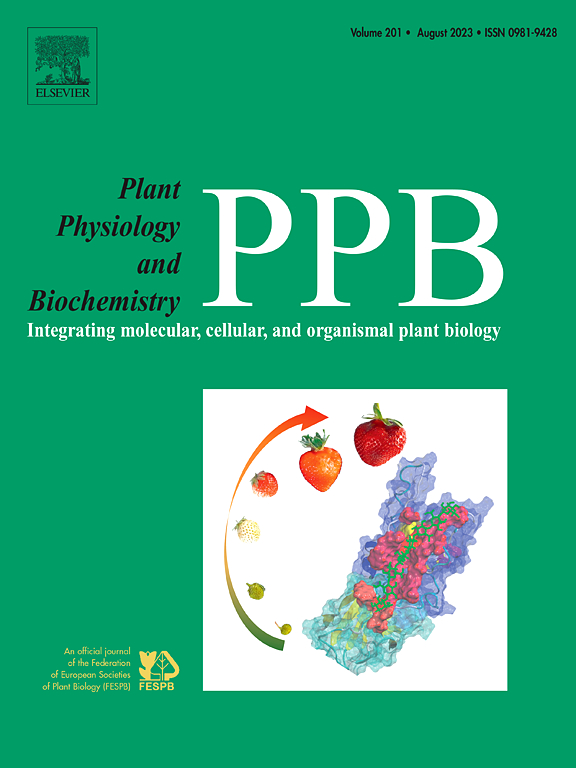Wheat transcription factor TaSIP1 participates in plant response to osmotic stress and abscisic acid
IF 5.7
2区 生物学
Q1 PLANT SCIENCES
引用次数: 0
Abstract
Environmental stresses, including drought and high salinity, induce osmotic stress that severely impairs plant growth and agricultural productivity. TaSIP1, a membrane-associated NAC transcription factor interacting with TaSRO1 (Triticum aestivum Similar to RCD-one 1), participates in salinity responses through mitochondria retrograde signaling. Here, we report a critical role of TaSIP1 in osmotic stress as well as abscisic acid (ABA) signaling in wheat and Arabidopsis (Arabidopsis thaliana). TaSIP1 was downregulated by polyethylene glyco (PEG), dehydration and ABA. TaSIP1 overexpression in both wheat and Arabidopsis exhibited hypersensitivity to osmotic stress and ABA during early seedling growth, whereas RNA interference (RNAi)-mediated knockdown wheat lines displayed the opposite phenotype. In the presence of ABA or osmotic stress, the transcript levels of ABA biosynthesis and signaling related genes increased in TaSIP-overexpressing transgenic Arabidopsis plants. TaSIP1 activated the transcription of ABA Deficient 2 (ABA2), ABA3, Sucrose Non-fermenting 1-Related Protein Kinase 2.2 (SnRK2.2) and ABA Insensitive 5 (ABI5) genes in Aradidopsis, and TaSRO1 attenuated the transactivation activity of TaSIP1. Notably, TaSIP1-overexpressing transgenic Aradidopsis plants showed reduced cellular ABA levels and downregulated stress-responsive gene expression. These findings establish TaSIP1 as a key regulator of osmotic stress responses, acting through the modulation of ABA signaling pathways.
小麦转录因子TaSIP1参与植物对渗透胁迫和脱落酸的响应
环境压力,包括干旱和高盐度,诱发渗透胁迫,严重损害植物生长和农业生产力。TaSIP1是一种与TaSRO1 (Triticum aestivum Similar to RCD-one - 1)相互作用的膜相关NAC转录因子,通过线粒体逆行信号参与盐度响应。在这里,我们报道了TaSIP1在小麦和拟南芥(Arabidopsis thaliana)的渗透胁迫和脱落酸(ABA)信号传导中的关键作用。聚乙二醇(PEG)、脱水和ABA均下调TaSIP1的表达。TaSIP1在小麦和拟南芥中过表达,在幼苗生长早期表现出对渗透胁迫和ABA的超敏感,而RNA干扰(RNAi)介导的低表达小麦系表现出相反的表型。在ABA或渗透胁迫下,过表达tasip的转基因拟南芥植物ABA生物合成和信号相关基因的转录水平升高。TaSIP1激活了Aradidopsis中ABA缺陷2 (ABA2)、ABA3、蔗糖非发酵1相关蛋白激酶2.2 (SnRK2.2)和ABA不敏感5 (ABI5)基因的转录,TaSRO1降低了TaSIP1的反激活活性。值得注意的是,过表达tasip1的转基因芥蓝植物显示细胞ABA水平降低,应激反应基因表达下调。这些发现表明TaSIP1是渗透胁迫反应的关键调节因子,通过调节ABA信号通路起作用。
本文章由计算机程序翻译,如有差异,请以英文原文为准。
求助全文
约1分钟内获得全文
求助全文
来源期刊
CiteScore
11.10
自引率
3.10%
发文量
410
审稿时长
33 days
期刊介绍:
Plant Physiology and Biochemistry publishes original theoretical, experimental and technical contributions in the various fields of plant physiology (biochemistry, physiology, structure, genetics, plant-microbe interactions, etc.) at diverse levels of integration (molecular, subcellular, cellular, organ, whole plant, environmental). Opinions expressed in the journal are the sole responsibility of the authors and publication does not imply the editors'' agreement.
Manuscripts describing molecular-genetic and/or gene expression data that are not integrated with biochemical analysis and/or actual measurements of plant physiological processes are not suitable for PPB. Also "Omics" studies (transcriptomics, proteomics, metabolomics, etc.) reporting descriptive analysis without an element of functional validation assays, will not be considered. Similarly, applied agronomic or phytochemical studies that generate no new, fundamental insights in plant physiological and/or biochemical processes are not suitable for publication in PPB.
Plant Physiology and Biochemistry publishes several types of articles: Reviews, Papers and Short Papers. Articles for Reviews are either invited by the editor or proposed by the authors for the editor''s prior agreement. Reviews should not exceed 40 typewritten pages and Short Papers no more than approximately 8 typewritten pages. The fundamental character of Plant Physiology and Biochemistry remains that of a journal for original results.

 求助内容:
求助内容: 应助结果提醒方式:
应助结果提醒方式:


